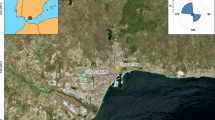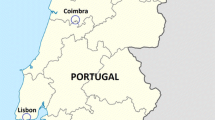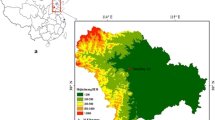Abstract
The airborne pollen concentration in the city of Badajoz was measured in two locations 2.9 km apart. The measurements were taken from January to June between 2009 and 2012 using Hirst-type volumetric aerobiological samplers. One sampler was placed at the Faculty of Science (FS) and the other at the Agricultural Engineering School (AES) of the University of Extremadura, Spain, on terraces located 16 and 6 m above ground, respectively. The two sets of hourly and daily pollen concentrations were compared regarding the meteorological parameters and the distribution of local pollen sources. A total of 46 pollen types were counted, with a mean total concentration of 43 pollen grains/m³ in the winter and 336 pollen grains/m³ in the spring. In the winter, pollen grains from (in decreasing order) Cupressaceae, Fraxinus–Phillyrea, Urticaceae spp., Alnus glutinosa and Urtica membranacea types represented 77 % of the total. In the spring, 89 % of the total was represented by pollen grains from (in decreasing order) Quercus, Poaceae, Olea, Pinaceae and Plantago. The FS/AES ratio was 0.57 in the winter and 1.31 in the spring. While a Wilcoxon test applied to the daily total concentration data showed statistically significant differences between the two sites, a correlation study based on the Spearman coefficient showed statistically significant correlations in both the winter and spring. The results were similar when comparing the separate pollen types, except for Urticaceae spp., which showed no statistically significant correlation. The meteorological data studied showed a statistically significant correlation with the daily concentrations. A comparison of the hourly concentration data showed no correspondence with the time of maximum concentration. The local distribution of pollen sources explained some of the differences found between the two sites. Overall, the results indicate that a single aerobiological sampler may be sufficiently representative to register the daily pollen grain data of an urban area of approximately 3 km or greater in diameter, although it underestimates the influence of heterogeneity in the distribution of the local flora.







Similar content being viewed by others
References
Abreu, I., & Ribeiro, H. (2005). Allergenic pollen in the city of Porto (Portugal). Allergy, 60, 1452–1453.
Alcázar, P., Galán, C., Cariñanos, P., & Domínguez-Vilches, E. (1998). Vertical variation in Urticaceae airborne pollen concentration. Aerobiologia, 14, 131–134.
Alcázar, P., Stach, A., Nowak, M., & Galán, C. (2009). Comparison of airborne herb pollen types in Córdoba (Southwestern Spain) and Poznan (Western Poland). Aerobiologia, 25, 55–63.
Arobba, D., Guido, M. A., Minale, P., Montanari, C., Placereani, S., Pracilio, S., et al. (2000). Airborne pollen in Genoa (NW-Italy): A comparison between two pollen-sampling stations. Aerobiologia, 16, 233–243.
Caeiro, E., Brandão, R., Carmo, S., Lopes, L., Morais de Almeida, M., Gaspar, Â., et al. (2007). Rede Portuguesa de Aerobiologia. Resultados da monitorização do pólen atmosférico (2002–2006). Revista Portuguesa Imunoalergologia, 15, 235–250.
Chakraborty, P., Gupta-Bhattacharya, S., Chowdhury, I., Majumdar, M. R., & Chanda, S. (2001). Differences in concentrations of allergenic pollens and spores at different heights on an agricultural farm in west Bengal, India. Annals of Agricultural and Environmental Medicine, 8, 123–130.
D’Amato, L., Cecchi, S., Bonini, C., Nunes, I., Annesi-Maesano, H., Behrendt, G., et al. (2007). Allergenic pollen and pollen allergy in Europe. Allergy, 62, 976–990.
D’Amato, G., Spieksma, F. M., Liccardi, G., Jäger, S., Russo, M., Kontou-Fili, K., et al. (1998). Pollen-related allergy in Europe. Allergy, 53, 567–578.
Docampo, S., Recio, M., Trigo, M. M., Melgar, M., & Cabezudo, B. (2007). Risk of pollen allergy in Nerja (southern Spain): A pollen calendar. Aerobiologia, 23, 189–199.
El-Ghazaly, G., El Ghazaly, P. K., Larsson, K. A., & Nilsson, S. (1993). Comparison of airborne pollen grains in Huddinge and Stockholm, Sweden. Aerobiologia, 9, 53–67.
Emberlin, J., Jäger, S., Domínguez, E., Galán, C., Hodal, L., Mandrioli, P., et al. (2000). Temporal and geographical variations in grass pollen seasons in areas of western Europe: An analysis of season dates at sites of the European pollen information system. Aerobiologia, 16, 373–379.
Emberlin, J., Jones, S., Bailey, J., Caulton, E., Cordon, J., Dubbels, S., et al. (1994). Variation in the start of the grass pollen season at selected sites in the United Kingdom, 1987–1992. Grana, 33, 94–99.
Emberlin, J., Mullins, J., Cordon, J., Jones, S., Millington, W., Brooke, M., et al. (1999). Regional variations in grass pollen seasons in the UK, long term trends and forecast models. Clinical and Experimental Allergy, 29, 347–356.
Eversmeyer, M., & Kramer, C. L. (1987). Single versus multiple sampler comparisons. Grana, 26, 109–112.
Fornaciari, M., Bricchi, E., Frenguelli, G., & Romano, B. (1996). The results of 2-years pollen monitoring of an urban network in Perugia, Central Italy. Aerobiologia, 12, 219–227.
Frenz, D. A., Melcher, S. E., Murray, L. W., & Sand, R. E. (1997). A comparison of total pollen counts obtained 5.6 km apart. Aerobiologia, 13, 205–208.
Galán, C., Alcázar, P., Domínguez, E., Villamandos de la Torre, F., & Infante, F. (1995). Airborne pollen grain concentrations at two different heights. Aerobiologia, 11, 105–109.
Galán, C., Cariñanos, P., Alcázar, P., & Domínguez, E. (2007). Spanish aerobiology network (REA): Manual de Calidad y Gestión de la Red Española de Aerobiología. Universidad de Córdoba: Servicio de Publicaciones. ISBN 978-84-690-6354-5.
Galán, C., Tormo, R., Cuevas, J., Infante, F., & Dominguez, E. (1991). Theoretical daily variations patterns of airborne pollen in the South-West of Spain. Grana, 30, 201–209.
Giorato, M., Bordin, A., Gemignani, C., Turatello, F., & Marcer, G. (2003). Airborne pollen in Padua (NE-Italy): A comparison between two pollen samplers. Aerobiologia, 19, 129–131.
Gioulekas, D., Papakosta, D., Damialis, F., Spieksma, F., Giouleka, D., & Patakas, D. (2004). Allergenic pollen records (15 years) and sensitization in patients with respiratory allergy in Thessaloniki, Greece. Allergy, 59, 174–184.
Gonzalo, A., Tormo, R., Muñoz, A., & Silva, I. (2006). Differences in the spatial distribution of airborne pollen concentrations at different urban locations within a city. Journal of Investigational Allergology and Clinical Immunology, 16, 37–43.
Gottardini, E., & Cristofolini, F. (1997). Spring airborne pollen data in two sites in Trentino (Northern Italy): A comparison with meteorological data. Aerobiologia, 13, 199–204.
Hirst, J. M. (1952). An automatic sporetrap. Annals of Applied Biology, 36, 257–265.
Irdi, G. A., Jones, J. R., & White, C. M. (2002). Pollen and fungal spore sampling and analysis. Statistical evaluations. Grana, 41, 44–47.
Jato, V., Rodríguez-Rajo, F. J., Alcázar, P., De Nuntiis, P., Galán, C., & Mandrioli, P. (2006). May the definition of pollen season influence aerobiological results. Aerobiologia, 22, 13–25.
Kasprzyk, I. (2004). Airborne pollen of entomophilous plant and spores of pteridofytes in Rzeszów and its environs (SE Poland). Aerobiologia, 20, 217–222.
Khattab, A., & Levetin, E. (2008). Effect of sampling height on the concentration of airborne fungal spores. Annals of Allergy, Asthma & Immunology, 101, 529–534.
Kramer, C. L., & Eversmeyer, M. G. (1984). Comparisons of aispora concentrations at various sites within a ten kilometer radius of Maniatan, Kansas, USA. Grana, 23, 117–122.
Nilsson, S., & Persson, S. (1981). Tree pollen spectra in the Stockholm region (Sweden) 1973–1980. Grana, 20, 179–182.
NSI (2012). Population by cities. Madrid, Spain. National Institute of Statistics.
Palmas, F., & Cosentino, S. (1990). Comparison between fungal airspore concentration at two different sites in the south of Sardinia. Grana, 29, 87–95.
Pedersen, B., & Moseholm, L. (1993). Precision of the daily pollen count. Identifying sources of variation using variance component models. Aerobiologia, 9, 15–26.
Pérez Badía, R., Vaquero, C., Sardinero, S., Galán, C., & García-Mozo, H. (2010). Intradiurnal variations of allergenic tree pollen in the atmosphere of Toledo (central Spain). Annals of agricultural and environmental medicine, 17, 37–43.
Piotrowska, K. (2004). Comparison of Alnus, Corylus and Betula pollen counts in Loubling (Poland) and Skien (Norway). Annals of Agricultural and Environmental Medicine, 11, 205–208.
Ribeiro, H., Cunha, M., & Abreu, I. (2008). Quantitative forecasting of olive yield in Northern Portugal using a bioclimatic model. Aerobiologia, 24, 141–150.
Sánchez-Mesa, J. A., Smith, M., Emberlin, J., Allitt, U., Caulton, E., & Galán, C. (2003). Characteristics of grass pollen seasons in areas of southern Spain and the United Kingdom. Aerobiologia, 19, 243–250.
Silva, I., Tormo, R., & Muñoz, A. (2007). The importance of interactions between meteorological conditions when interpreting their effect on the dispersal of pollen from homogeneously distributed sources. Aerobiologia, 23, 17–26.
Skjøth, C. A., Smith, M., Brandt, J., & Emberlin, J. (2009). Are the birch trees in Southern England a source of Betula pollen for North London? International Journal of Biometeorology, 53, 75–86.
Staffolani, L., Velasco, M. J., Galán, C., & Hruska, K. (2011). Allergenicity of the ornamental urban flora: Ecological and aerobiological analyses in Córdoba (Spain) and Ascoli Piceno (Italy). Aerobiologia, 27, 239–246.
Strandhede, S. O., & Wihl, J. A. (1981). Comparison of pollen counts in Copenhagen and Malmö. Grana, 20, 187–189.
Thibaudon, M., & Sulmont, G. (2002). Influence of the height position of two pollen traps in Amiens. Allergie et Immunologie, 34, 169–171.
Tormo, R., Maya, J. M., Fernández-Rodríguez, S., Gonzalo, A., & Silva, I. (2013). Influence of environmental factors on measurements with Hirst spore traps. Grana, 52, 59–70. doi:10.1080/00173134.2012.718359.
Tormo, R., Muñoz, A. F., & Silva, I. (1996). Sampling in aerobiology. Differences between traverses along the lenght of the slide in Hirst sporetraps. Aerobiologia, 12, 161–166.
Trigo, M. M., Recio, M., Toro, F. J., & Cabezudo, B. (1997). Intradiurnal fluctuations in airborne in Málaga (S. Spain): A quantitative method. Grana, 36, 39–43.
Trigo, M. M., Toro, F. J., Recio, M., & Cabezudo, B. (2000). A statistical approach to comparing the results from different aerobiological stations. Grana, 39, 252–258.
Velasco-Jiménez, M. J., Alcázar, P., Domínguez-Vilches, E., & Galán, C. (2012). Comparative study of airborne pollen counts located in different areas of the city of Córdoba (south-western Spain). Aerobiologia,. doi:10.1007/s10453-012-9267-x.
Acknowledgments
This work was made possible by the research projects PRI06A190 and PRI BS10008 financed by the Regional Government, Junta de Extremadura (Spain) and the European Social Fund.
Author information
Authors and Affiliations
Corresponding author
Rights and permissions
About this article
Cite this article
Fernández-Rodríguez, S., Tormo-Molina, R., Maya-Manzano, J.M. et al. Comparative study of the effect of distance on the daily and hourly pollen counts in a city in the south-western Iberian Peninsula. Aerobiologia 30, 173–187 (2014). https://doi.org/10.1007/s10453-013-9316-0
Received:
Accepted:
Published:
Issue Date:
DOI: https://doi.org/10.1007/s10453-013-9316-0




